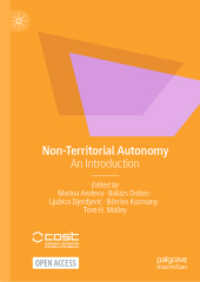- ホーム
- > 洋書
- > 英文書
- > Business / Economics
Full Description
The book introduces and discusses the modern theory of the cost of capital and capital structure - the BFO theory (Brusov-Filatova-Orekhova theory), which is valid for companies of arbitrary age and which replaced the theory of Nobel laureates Modigliani and Miller. The theory takes into account the conditions faced by companies operating in the real economy, such as revenue fluctuations; the arbitrary frequency of tax on profit payments (monthly, quarterly, semi-annual or annual payments), both for advance income tax payments and for payments at the end of the respective period; and the arbitrary frequency of interest on loans payments. The impact of these conditions on the company value, on the cost of raising capital, on the company's dividend policy and managerial decisions are discussed. The book subsequently develops new applications of the BFO theory in several areas such as corporate finance, corporate governance, investments, taxation, business valuations and ratings.
Contents
Introduction.- Capital Structure Theory: Past, Present, Future.- Main Theories of Capital Structure.- Modern theory of capital cost and capital structure - Brusov-Filatova-Orekhova theory (BFO theory).- Bankruptcy of the famous trade off theory.- New mechanism of formation of the company optimal capital structure, different from suggested by trade off theory.- The global causes of the global financial crisis.- The role of taxing and leverage in evaluation of capital cost and capitalization of the company.- A qualitatively new effect in corporate finance: abnormal dependence of equity cost of company on leverage.- Inflation in Brusov-Filatova-Orekhova theory and in its perpetuity limit - Modigliani - Miller theory.- Benefits of Advance Payments of Tax on Profit: Consideration within Brusov-Filatova-Orekhova (BFO) Theory.- The Generalization of the Brusov-Filatova-Orekhova Theory for the Case of Payments of Tax on Profit with Arbitrary Frequency.- Influence of Method and Frequencyof Profit Tax Payments on Company Financial Indicators.- Generalization of the Brusov-Filatova-Orekhova Theory for the Case of Variable Income.- BFO Theory with Variable Profit in Case of Advance Payments of Tax on Profit.- BFO Theory with Variable Profit: Two Types of Payments of Tax on Profit: Advanced Payments and at the Ends of Periods.- Investment models with debt repayment at the end of the project and their application.- Investment Models with Uniform Debt Repayment and Their Application.- The analysis of the exploration of efficiency of investment projects of arbitrary duration (within Brusov-Filatova-Orekhova theory).- Whether it is possible to increase taxing and conserve a good investment climate in the country?.- Whether it is possible to increase of the investment effi-ciency, increasing tax on profit rate?.- Optimizing the Investment Structure of the Telecommunication Sector Company.- Innovative Investment Models with Frequent Payments of Tax on Income and of Interest on Debt.- The Role of the Central Bank and Commercial Banks in Creating and Maintaining of a Favorable Investment Climate in the Country.- The Golden Age of the Company (Three Colors of Company's Time).- A "golden age" of the companies: Conditions of its existence.- New meaningful effects in modern capital structure theory.- Rating: New Approach.- Rating methodology: new look and new horizons.- Application of the Modigliani-Miller Theory, Modified For the Case of Advance Payments of Tax on Profit, in Rating Methodologies.- Ratings of the Investment Projects of Arbitrary Durations: New Methodology.- Ratings of Investment Projects of Arbitrary Duration with a Uniform Debt Repayment: a new approach.- Conclusions







